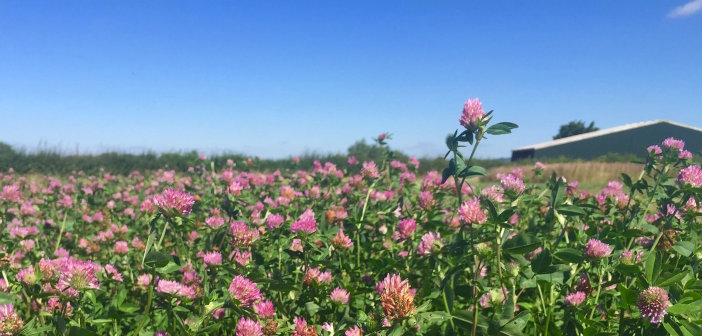Buoyant soya prices, carbon reduction efforts and concerns about nitrogen management have led to increased interest in protein-rich forage legumes, reports Barenbrug UK, which has seen strong enquiries for its red clover varieties.
“Soya has been trading at well over £400/t this year,” said Mhairi Dawson, Barenbrug UK’s research and development manager and regional manager for Scotland. “That’s prompted people to give more consideration to how they source their essential protein ration.”
Ms Dawson added that farmers are increasingly aware of the need to reduce carbon ‘spending’ and are making conscious decisions to reduce food miles – high, in the case of imported soya – and are trying to cut back on carbon-intensive inputs such as nitrogen fertiliser.
Red clover’s ability to fix more than 200kg per hectare of nitrogen is one of the factors driving its popularity, following speculation that under the new Agriculture Bill nitrate vulnerable zones could be expanded or that there will be a stricter approach to nitrogen applications.

“Red clover presents an opportunity to reduce artificial nitrogen, yet maintain a high-quality forage,” Ms Dawson said. “Defra’s recent urea fertiliser consultation has increased expectations that things will change, eventually, and I think that’s encouraged farmers to consider how they might adapt their operations, to adopt a more sustainable approach.”
As a forage, red clover is palatable and has a favourable crude protein level of 18-20%, making it a good legume choice in pure grass awards. Increased intakes can boost both milk yields and daily liveweight gain and, as a deep rooting, flowering species, it has the potential to be beneficial to the soil structure, building organic matter and providing a food source for pollinators.
Research conducted last year amongst 200 farmers in the Netherlands, where red clover has become well-established, revealed quality, high protein yields, biodiversity and nitrogen reduction were the main factors driving adoption of the legume. In addition, 73% said they planned to continue their use of red clover.
“We also looked at the most successful farmers, those having consistent success growing red clover, to identify which management practices delivered the best results,” explained Ms Dawson. “It’s this research that has informed our new red clover management guidelines.”
Guidelines for red clover success
- Sow in summer, not in spring
- Drilling rate should be a minimum of 5kg/ha
- Do not cut clover below 7cm. Manage the growing crown very carefully
- Allow the crop to reach at least 3,500kg dry matter per hectare before cutting. Do not rely on any percentage of flowering.
- Use no more than 100kg of nitrogen fertiliser per hectare each year
- Red clover benefits from high phosphorus and potassium levels, so there are no restrictions on organic matter.
More information is available from the Barenbrug UK website.


